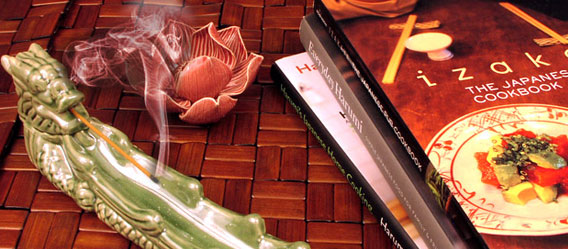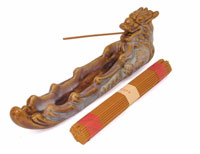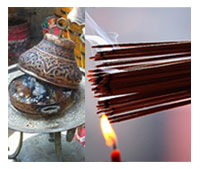|

Think incense, and religious ceremonies might come to mind. Think cosmetics, embalming and medicines, and incense might be the last thing you would think of.
It's hard to believe incense is as old as history itself, and yet, it has been mentioned in records that place it as far back as 3,000 BC. In North America, the use of incense was documented in 15th and early 16th centuries during the first encounters between natives and the Europeans. At birth, Jesus Christ received a gift of frankincense and myrrh from the Three Wise Men, which is an indication of its value and worth even at that time.
 Since ancient times, incense has been a feature in religious ceremonies all over the world. The early Egyptians and Indians used incense in sacrificial rituals, and it was the Egyptians who used oil of myrrh for embalming. Later on, it was they who discovered other uses for incense, such as ritual, medical, even cosmetic. Greeks burned incense for protection, Buddhists burned them at festivals and initiation rites, and the early Christian church used incense to symbolize the rise of prayers, honor God and the saints. The Chinese used incense to honor their ancestors and other divine beings, a practice still maintained today. Since ancient times, incense has been a feature in religious ceremonies all over the world. The early Egyptians and Indians used incense in sacrificial rituals, and it was the Egyptians who used oil of myrrh for embalming. Later on, it was they who discovered other uses for incense, such as ritual, medical, even cosmetic. Greeks burned incense for protection, Buddhists burned them at festivals and initiation rites, and the early Christian church used incense to symbolize the rise of prayers, honor God and the saints. The Chinese used incense to honor their ancestors and other divine beings, a practice still maintained today.
It is the resins of various plants, such as frankincense and myrrh (two trees found mainly in places such as Somalia and Ethiopia), that is technically known as incense, but because of rising manufacturing costs, natural and herbal ingredients are sometimes replaced by synthetic substitutes, and traditional productions have given way to mechanical mass production. In the West today, frankincense, myrrh, rose petals, lavender, cedar, bay, sandalwood and rosemary are some of the most frequently used ingredients.
 Combustible and noncombustible are two of the more commonly available types of incense. Combustible incense takes shape in the form of sticks, cones or other shapes, while noncombustible incense comes in a finely grounded powder form and must be sprinkled directly into the fire in order to release its fragrance. The most common way is to place charcoal blocks in a fireproof container, and then place the incense on the blocks. Combustible incense contains saltpeter, or potassium nitrate, which allows it to burn without the help of charcoal. Combustible and noncombustible are two of the more commonly available types of incense. Combustible incense takes shape in the form of sticks, cones or other shapes, while noncombustible incense comes in a finely grounded powder form and must be sprinkled directly into the fire in order to release its fragrance. The most common way is to place charcoal blocks in a fireproof container, and then place the incense on the blocks. Combustible incense contains saltpeter, or potassium nitrate, which allows it to burn without the help of charcoal.
Although the actual practice of aromatherapy can be traced back to early civilizations in India, China, and Egypt, it was French chemist, Rene Maurice Gattefosse, who first introduced the term to the rest of the world in 1937, an introduction ridiculed by the medical community at the time. It has only been within the last several decades that aromatherapy has gained greater acceptance, and those who believe in this ancient healing rite are rewarded with its various effects. Initially used to treat many diseases, burning incense has long played an important part in spiritual practices by calming the mind, and relaxing the spirit and senses. In meditation, it helps center one's energy and increases mental clarity, and because natural and nontoxic, incense makes a sensible, nonpolluting alternative to modern aerosol air fresheners.
 Keeping in mind recent events that have unfolded in the past few months, and the stress of the holidays just barely behind us, aromatherapy seems like an inexpensive and undemanding way to help promote tranquility and aid spiritual angst. Mrs. Lin's Kitchen carries incense in a variety of fragrances such as sandalwood, jasmine and pine, and incense burners that are as attractive as they are functional. Let us help make the start of your spiritual journey a smooth and effortless one. Keeping in mind recent events that have unfolded in the past few months, and the stress of the holidays just barely behind us, aromatherapy seems like an inexpensive and undemanding way to help promote tranquility and aid spiritual angst. Mrs. Lin's Kitchen carries incense in a variety of fragrances such as sandalwood, jasmine and pine, and incense burners that are as attractive as they are functional. Let us help make the start of your spiritual journey a smooth and effortless one.
|
|
|
OUR 2002 NEWSLETTERS
December Celebrations in Asia
The Principles of Japanese Tableware
The Art of Eglomise
The Three Most Popular Thai Herbs
JADE: The Stone of Immortality and Beauty
The Legend of Daruma
The Lucky Cat
The Art of Beautiful Writing
All Steamed Up: Springtime Mushimono
Chinese ID: The Chop/Seal
Cast Away Illness with Cast Iron
Incense
NEWSLETTER ARCHIVES
2011
2010
2009
2008
2007
2006
2005
2004
2003
2002
2001
MAY WE SUGGEST:
|